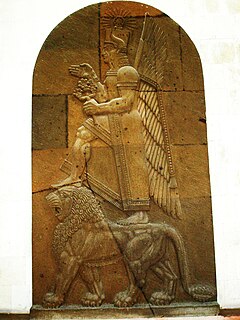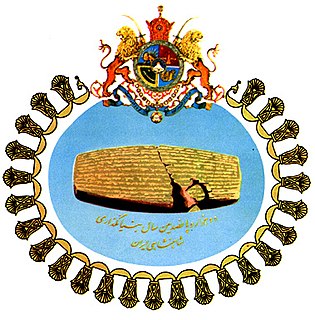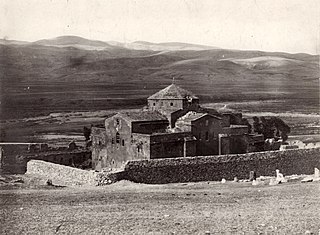Related Research Articles

Nowruz is the Persian-language term for the day of the Iranian New Year, also known as the Persian New Year. It begins on the spring equinox and marks the beginning of Farvardin, the first month of the Solar Hijri calendar. The day is celebrated worldwide by various ethnolinguistic groups and falls on or around the date of 21 March on the Gregorian calendar.

Elam was an ancient civilization centered in the far west and southwest of modern-day Iran, stretching from the lowlands of what is now Khuzestan and Ilam Province as well as a small part of southern Iraq. The modern name Elam stems from the Sumerian transliteration elam(a), along with the later Akkadian elamtu, and the Elamite haltamti. Elamite states were among the leading political forces of the Ancient Near East. In classical literature, Elam was also known as Susiana, a name derived from its capital Susa.

Ḫaldi was one of the three chief deities of Urartu along with Teisheba and Shivini. He was a warrior god to whom the kings of Urartu would pray for victories in battle. Ḫaldi was portrayed as a man with or without wings, standing on a lion.

Yazata is the Avestan word for a Zoroastrian concept with a wide range of meanings but generally signifying a divinity. The term literally means "worthy of worship or veneration", and is thus, in this more general sense, also applied to certain healing plants, primordial creatures, the fravashis of the dead, and to certain prayers that are themselves considered holy. The yazatas collectively are "the good powers under Ahura Mazda", who is "the greatest of the yazatas".

Newroz or Nawroz is the Kurdish celebration of Nowruz; the arrival of spring and new year in Kurdish culture. The lighting of the fires at the beginning of the evening of March 21 is the main symbol of Newroz among the Kurds.

Vahagn Vishapakagh or Vahakn was a god of fire, thunder, and war worshiped in ancient Armenia. Some time during ancient history, he formed a "triad" with Aramazd and Anahit. Vahagn is derived from *Varhraγn, the Parthian name for the Iranian god Verethragna.

Armenian mythology originated in ancient Indo-European traditions, specifically Proto-Armenian, and gradually incorporated Hurro-Urartian, Mesopotamian, Iranian, and Greek beliefs and deities.

The Proto-Albanian language is the unattested language from which Albanian later developed. Albanian evolved from an ancient Paleo-Balkan language, traditionally thought to be Illyrian, or otherwise a totally unattested Balkan Indo-European language that was closely related to Illyrian and Messapic, which is sometimes also referred to as Albanoid.
Aramazd was the chief and creator god in the Armenian version of Zoroastrianism. The deity and his name were derived from the deity Ahura Mazda after the Median conquest of Armenia in the 6th century BC. Aramazd was regarded as a generous god of fertility, rain, and abundance, as well as the father of the other gods, including Anahit, Mihr, and Nane. Like Ahura Mazda, Aramazd was seen as the father of the other gods, rarely with a wife, though sometimes husband to Anahit or Spandaramet. Aramazd was the Parthian form of Ahura Mazda.
Harā Bərəzaitī, is the name given in the Avestan language to a legendary mountain around which the stars and planets revolve.
The Armenian calendar is the calendar traditionally used in Armenia, primarily during the medieval ages.

The Celebration of the 2,500th Anniversary of the Founding of the Persian Empire was a national event in Iran that consisted of an elaborate set of grand festivities during October 1971 to celebrate the founding of the ancient Achaemenid Empire by Cyrus the Great. The intent of the celebration was to highlight Iran's ancient civilization and history as well as to showcase its contemporary advances under Shah Mohammad Reza Pahlavi. The celebrations highlighted Iran's Aryan roots and pre-Islamic origins while promoting Cyrus the Great as a national hero.
The origin of the Armenians is a topic about the emergence of the Armenian people and the country called Armenia. The earliest universally accepted reference to the people and the country dates back to the 6th century BC Behistun Inscription, followed by several Greek fragments and books. The earliest known reference to a geopolitical entity where Armenians originated from is dated to the 13th century BC as Uruatri in Old Assyrian. Historians and Armenologists have speculated about the earlier origin of the Armenian people, but no consensus has been achieved as of yet. Linguistically, Armenians have been speaking an Indo-European language for as long as it has been attested since the 5th century AD, and genetic studies show that Armenian people are indigenous to historical Armenia, showing little to no signs of admixture since around the 13th century BC.

Vardavar or Vartavar ) is an Armenian festival in Armenia where people drench each other with water. The festival is also observed by Hemshin people of Turkey, a Muslim majority group of Armenian origin.
In the earliest prehistoric period Astłik had been worshipped as the Armenian deity of fertility and love, later the skylight had been considered her personification, and she had been the consort of Vahagn. In the later heathen period she became the goddess of love, maidenly beauty, and water sources and springs.
Numerous lexemes that are reconstructable for Proto-Slavic have been identified as borrowings from the languages of various tribes that Proto-Slavic speakers came into contact with, either in prehistorical times or during their expansion when they first appeared in history in the 6th century. Most of the loanwords come from Germanic languages, with other contributors being Iranian, Celtic, and Turkic. The topic of such loanwords in Slavic has sparked numerous sharp debates in the 20th century, some of which persist to this day.

Aryan or Arya is a term originally used as an ethnocultural self-designation by Indo-Iranians in ancient times, in contrast to the nearby outsiders known as 'non-Aryan' (*an-arya). In Ancient India, the term ā́rya was used by the Indo-Aryan speakers of the Vedic period as an endonym (self-designation) and in reference to a region known as Āryāvarta, where the Indo-Aryan culture emerged. In the Avesta scriptures, ancient Iranian peoples similarly used the term airya to designate themselves as an ethnic group, and in reference to their mythical homeland, Airyanǝm Vaēǰō. The stem also forms the etymological source of place names such as Iran (*Aryānām) and Alania (*Aryāna-).

Bagavan was an ancient locality in the central part of Armenia in the principality of Bagrevand. The site is located in the village of Taşteker to the west of modern Diyadin, Turkey. Situated on a tributary of the Euphrates at the foothills of Mount Npat, to the north of Lake Van, Bagavan held one of the major temples of pre-Christian Armenia. After the Christianization of Armenia, Bagavan became the site of a large church and monastery. Pillaged in 1877 by the Kurds, it was completely destroyed after 1915 during the Armenian genocide.

Zoroastrianism in Armenia dates back as far as to the fifth-century BC, notably during the Achaemenid and Parthian periods in the Armenian Highlands. Prior to Armenia's Christianisation, it was a predominantly Zoroastrian-adhering land. The yazatas Mithra (Mihr) and Verethragna (Vahagn) particularly enjoyed a high degree of reverence in the country.
Tir or Tiur was the god of written language, schooling, rhetoric, wisdom, and the arts worshiped in ancient Armenia.
References
- ↑ Khachatryan, Hayk (2003). Հայոց Հնօրյա Զվարճախոսները. Yerevan: "Amaras". p. 118.
- ↑ Ananikean, Mardiros Harootioon (2010). Armenian Mythology: Stories of Armenian Gods and Goddesses, Heroes and Heroines, Hells & Heavens, Folklore & Fairy Tales. Los Angeles: IndoEuropean Publishing.com. ISBN 978-1-6044-4172-7.